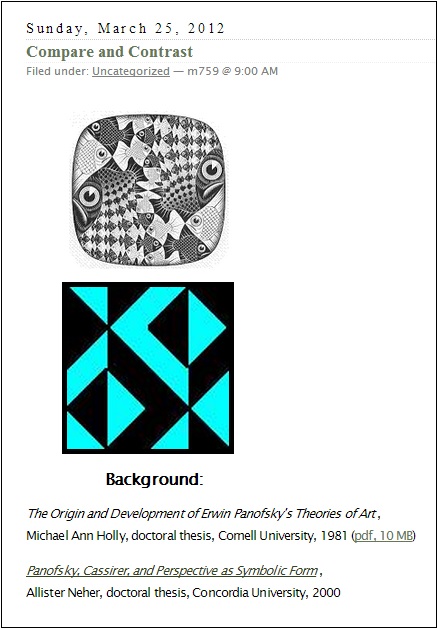Monday, June 30, 2014
For the title, see a post of Nov. 4, 2007.
Related material:
Hexagram 29, Water, and a pattern resembling
the symbol for Aquarius:

 .
.
For some backstory about the former,
see the June 21 post Hallmark.
For some backstory about the latter,
see today’s post Toward Evening.
Tom Wolfe has supplied some scaffolding*
to support the concept.
* A reference to Grossman and Descartes.
Comments Off on High Concept
“There’s a Michelangelo joke to be made.”
— Remark in the recent film “The Monuments Men”
Vide Michelangelo in this journal.
Comments Off on Joke
(Friday’s Latin Club posts, continued)
The poet Allen Grossman reportedly died in
the morning on Friday, June 27, 2014.


Comments Off on Toward Evening
Sunday, June 29, 2014
Comments Off on Sunday School
New York Times lead obit at 11:06 PM ET June 28:
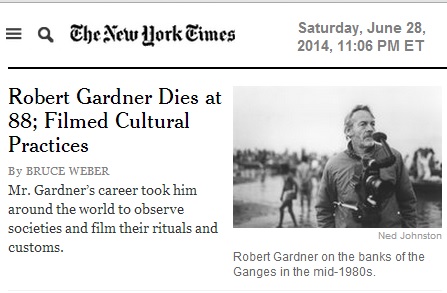
Compare and contrast:

The above video promoting a book, The OMG Chronicles , was
uploaded by a marketer on March 1, 2011. For a different perspective,
see this journal on that date.
Comments Off on Chronicles
Friday, June 27, 2014

Related material:

See also this journal on the date of the above Mass: June 15, 2014—
Comments Off on Latin Club
“They always print… the lottery.” —Log24

See also posts 953 and 4016.
Comments Off on Numbers

“We specialize in bachelorette parties.”
Comments Off on Night of the Iguana Club
(Continued)

Mach die Musik von damals nach.
Comments Off on Claves

See related stories here and here.
Comments Off on Willkommen
Thursday, June 26, 2014
(Continued)
“What’s on the program?”
— Seymour Glass to Sybil in “A Perfect Day for Bananafish”
Related material from yesterday afternoon…

… and from this morning:

Comments Off on Where Entertainment Is God
(Continued from 10:09 AM today)
The quotation below is from a webpage on media magnate
Walter Annenberg.
Annenberg Hall at Harvard, originally constructed to honor
the Civil War dead, was renamed in 1996 for his son Roger,
Harvard Class of ’62.
www.broadcastpioneers.com/
walterannenberg.html —
“It was said that Roger was ‘moody and sullen’
spending large parts of his time reading poetry
and playing classical music piano. It had been
reported that Roger attempted suicide at the
age of eleven by slitting his wrists. He recovered
and was graduated Magna Cum Laude from
Episcopal Academy in our area. For awhile,
Roger attended Harvard, but he was removed
from the school’s rolls after Roger stopped doing
his school work and spent almost all his time
reading poetry in his room. He then was sent to
an exclusive and expensive treatment center
in Bucks County, Pennsylvania. At that facility,
Roger became more remote. It was said that he
often didn’t recognize or acknowledge his father.
On August 7, 1962, Roger Annenberg died from
an overdose of sleeping pills.”
A more appropriate Annenberg memorial, an article
in The Atlantic magazine on June 25, notes that…
“Among those who ended up losing their battles
with mental illness through suicide are
Virginia Woolf, Ernest Hemingway, Vincent van Gogh,
John Berryman, Hart Crane, Mark Rothko, Diane Arbus,
Anne Sexton, and Arshile Gorky.”
Comments Off on Study This Example, Part II
The authors of the following offer an introduction to symmetry
in quilt blocks. They assume, perhaps rightly, that their audience
is intellectually impaired:

“A quilt block is made of 16 smaller squares.
Each small square consists of two triangles.”
Study this example of definition.
(It applies quite precisely to the sorts of square patterns
discussed in the 1976 monograph Diamond Theory , but
has little relevance for quilt blocks in general.)
Some background for those who are not intellectually impaired:
Robinson’s book Definition , in this journal and at Amazon.
Comments Off on Study This Example
"History is a deep and complicated puzzle—
especially when it involves more dimensions than time."
— Introduction to a novella in Analog Science Fiction

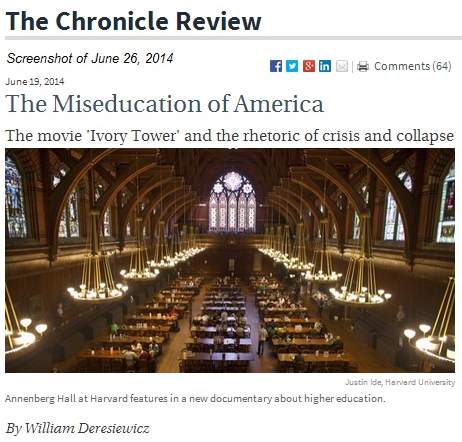

"Annenberg Hall" at Harvard was originally part of a memorial for
Civil War dead. Formerly "Alumni Hall," it was renamed in 1996.
Comments Off on The McLuhan Dimension
Wednesday, June 25, 2014
In memory of an actor “who as a boy was one of the few Jewish children
in his mostly Italian-American neighborhood in Brooklyn” —
See the link nocciolo from The Book of Abraham (Oct. 7, 2013).
Comments Off on Nocciolo
Tuesday, June 24, 2014
Introduction to a review of two books in
The American Interest , June 17, 2014:
“A believer and an atheist seek out their antitheses.
Do they meet somewhere in the middle,
or pass in the murk of half-baked pseudo-syntheses?”
Soundtrack:
“Waiting for the harvest, and the time of reaping,
We shall come rejoicing, passing in the murk.”
Related material:
This morning’s passage by Friedrich Gundolf.
For some backstory, see Gundolf in
Secret Germany: Stefan George and His Circle ,
by Robert E. Norton, Cornell University Press, 2002.
Comments Off on Passing in the Murk
… und Nachtformen des Urgrundes
From George , by Friedrich Gundolf (Berlin, Bondi, 1920):
Wenn das Schlußgedicht des Teppichs "Der Schleier"
das ganze gestaltige "Leben" des Dichters als
einen Traum-nu des Geistes zeigt so ist damit
der Geistestag vollbracht und der Geist selbst
der dies vermag ist am Ende seiner Herrschaft
er steht vor dem Urgrund der ihn bewegt:
er erkennt sich selbst wenn nicht als Stoff
so doch als Kraft zu träumen. Die kosmische Nacht
in die er blickt ist zugleich Widerspiel des Gestaltenreiches
das er als Geist der Erde verwirk licht
und Widerspiel des Gesetzes das er als Geist des Lebens
verewigt kurz sie ist Traum und Tod "Traum"
nicht als die Fülle der Gesichte sondern als "Maja"
die Scheinung des Wesens vermöge
deren der Urgrund sich der Bindung im Raum immer wieder entzieht
wie er im Tod der Bindung durch die Zeit entgeht.
Traum ist die Aufhebung des Raum-Ichs,
Tod die Aufhebung des Zeit-Ichs— beides sind
Nachtformen des Urgrundes
die raumschaffende und -vernichtende Bewegung und
das zeitschaffende und -vernichtende Sein.
The original:

Related material: Die Scheinung in this journal.
Comments Off on Die Scheinung des Wesens
Monday, June 23, 2014
Or: Mathematics and Narrative, Continued
In memory of a Stanford Arabist who reportedly died yesterday:

Another dream palace, from science fiction:

From Catherine Asaro’s The Spacetime Pool :
|
She couldn’t believe him. That he sounded sane made none of this more plausible. “And you have no idea how this gate works?” she challenged.
His gaze flashed. “Of course I do. It’s a branch. From here to your mountains.”
“A tree, you mean?”
“No. A branch cut to another page. Your universe is one sheet, mine is another.”
She gaped at him. “Do you mean a Riemann sheet? A branch cut from one Riemann sheet to another?”
“That’s right.” He hesitated. “You know these words?”
She laughed unsteadily. “It’s nonsense. Not the sheets, I mean, but they’re just mathematical constructs! They don’t actually exist. You can’t physically go through a branch cut any more than you could step into a square root sign.”
He was watching her with an expression that mirrored how she had felt when he told her about his prophecy. “I have no idea what you’re talking about.”
“Complex variable analysis.” She felt as if she were in a play where she only knew part of the script. “A branch cut is like a slit in a sheet of paper. It opens onto another sheet. I suppose you could say the sheets are alternate universes. But they aren’t real.”
“They seem quite real,” he said. |
Related material: From Sunday, the day of the Stanford Arabist’s death,
a quotation from a 2013 book on “the rise of complex function theory.”
Comments Off on Dream Palace
Sunday, June 22, 2014
(Continued)
Some bizarre remarks on “purity” in the previous post
suggest a review of some pure mathematics.

Comments Off on Göpel and Rosenhain
Saturday, June 21, 2014
A suitable hallmark for
the previous post, Logical Death:
29

Hexagram 29: "K'an represents…
the principle of light inclosed in the dark."
— The Richard Wilhelm I Ching
A related page from Stanford:

Comments Off on Hallmark
The May 29 death of a Stanford logician, combined
with this morning’s previous post, suggests a review
of the May 29 post Lost in Translation.
Context— Posts tagged “Bregnans.”
Comments Off on Logical Death
“… near-death experiences have all the
hallmarks of mystical experience…”
— “Bolt from the Blue,” by Oliver Sacks
(See “Annals of Consciousness,” June 20, 2014)
The late Charles Barsotti once “worked for Kansas City-based
Hallmark Cards,” according to an obituary.

See also Mad Day.
Some related deconstructive criticism:


Comments Off on When You Care Enough…
Friday, June 20, 2014
A search for the late Charles Barsotti’s art
in this journal leads to the following passage:

For related material from Bloomsday 2014,
the date of Barsotti’s death, see posts tagged
“consciousness growth.”
Update of 2 AM June 21, 2014:
“… near-death experiences have all the
hallmarks of mystical experience…”
— “Bolt from the Blue,” by Oliver Sacks
Barsotti once “worked for Kansas City-based
Hallmark Cards,” according to an obituary.
Comments Off on Annals of Consciousness
Tonight I finally got around to seeing "Return of the King,"
the end of Peter Jackson's Lord of the Rings trilogy, and
listened to Annie Lennox sing "Into the West"* over the
closing credits.
Searching for some background on the song, I found it
was said to have been first publicly performed at the funeral
of a young New Zealand filmmaker, Cameron Duncan.
Duncan reportedly died in Houston, Texas,
on November 12, 2003. See posts from that day and
the day before now tagged 'For Cameron Duncan."
* There is a 1992 film with the same title about Irish Travellers.
Comments Off on Into the West
Thursday, June 19, 2014
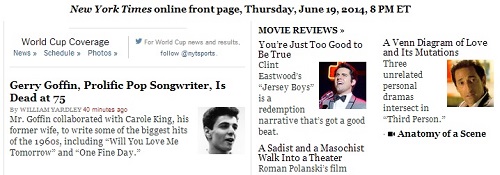
See also, in this journal, Song Hook.
Comments Off on Hook
Wednesday, June 18, 2014
Comments Off on Look for…
The title refers to…
- A Log24 post of 7:59 AM ET today
- A New York Times story of 11:59 AM ET today:


Online Etymology Dictionary on the title of the first Holden Caulfield
story, “I’m Crazy,” in Collier’s , December 22, 1945 —
Meaning “full of cracks or flaws” is from 1580s;
that of “of unsound mind, or behaving as so” is from 1610s.
Jazz slang sense “cool, exciting” attested by 1927….
Phrase crazy like a fox recorded from 1935.
Comments Off on For the Monuments Men
This journal on the morning of January 27, 2010,
the day of J. D. Salinger’s death, had a post on
Nietzsche and Heraclitus titled “To Apollo.”
Related material:
“… the wind was noisy the way it is in spooky movies
on the night the old slob with the will gets murdered.”
— From the opening sentence of the first Holden Caulfield
story, published in the Collier’s of December 22, 1945
See also Peter Matthiessen on Zen, Salinger and Vedanta,
and Heraclitus in this journal. Some background—
A quotation from Nietzsche…
(Sämtliche Werke, Kritische Studienausgabe in 15 Bänden (KSA).
Herausgegeben von Giorgio Colli und Mazzino Montinari.
Berlin: De Gruyter, 1980):
“Nietzsche wrote:
‘Seeing the world as a divine game and beyond good and evil:
in this both the Vedanta and Heraclitus are my predecessors.'”
— KSA vol. 11, page 26, as quoted by André van der Braak
in a chapter from his 2011 book Nietzsche and Zen
(Darin, dass die Welt ein göttliches Spiel sei
und jenseits von Gut und Böse —
habe ich die Vedanta-Philosophie
und Heraklit zum Vorgänger.)
Comments Off on A Dark and Stormy Night
Comments Off on For the Class of ’45
Tuesday, June 17, 2014
The previous two posts were on adman Julian Koenig,
who reportedly died on Thursday, June 12, 2014.
Wikipedia on Koenig:
He was married twice, first to Aquila Connolly,
and later to Maria Eckhart. He has four children:
Pim, an artist; John, a businessman and
horseracing enthusiast; Antonia, a law student;
and Sarah, a producer for the public radio show
This American Life.
The Hotchkiss School on Peter Matthiessen ’45:
Mr. Matthiessen is survived by his wife, Maria Eckhart;
… two stepdaughters, Antonia and Sarah Koenig ….
See also Log24 posts referring to “Matthiessen.”
(These include references to one F. O. Matthiessen, who according
to the Guardian in 2002 was a cousin of Peter Matthiessen’s father.)
Comments Off on The Plot Thickens
In memory of ad writer Julian Koenig, who apparently
coined the phrase “Earth Day” for April 22 (his birthday):
See also all instances of the phrase “colorful tale” in this journal.
Comments Off on Colorful Tale (continued)

Koenig reportedly died on Thursday, June 12, 2014.
Comments Off on Psyops Pioneer
Continued.
Anyone tackling the Raumproblem described here
on Feb. 21, 2014 should know the history of coordinatizations
of the 4×6 Miracle Octad Generator (MOG) array by R. T. Curtis
and J. H. Conway. Some documentation:

The above two images seem to contradict a statement by R. T. Curtis
in a 1989 paper. Curtis seemed in that paper to be saying, falsely, that
his original 1973 and 1976 MOG coordinates were those in array M below—

This seemingly false statement involved John H. Conway's supposedly
definitive and natural canonical coordinatization of the 4×6 MOG
array by the symbols for the 24 points of the projective line over GF(23)—
{∞, 0, 1, 2, 3… , 21, 22}:

An explanation of the apparent falsity in Curtis's 1989 paper:
By "two versions of the MOG" Curtis seems to have meant merely that the
octads , and not the projective-line coordinates , in his earlier papers were
mirror images of the octads that resulted later from the Conway coordinates,
as in the images below.

Comments Off on Finite Relativity

See also Ian McKellen in Neverwas and Gods and Monsters .
Comments Off on More Glass
Monday, June 16, 2014
See the January 6, 2014, post For the Padres
as well as Consciousness Growth.

Comments Off on Epiphany
Sunday, June 15, 2014

Related material: Aaron Eckhart in “Neverwas.”
Comments Off on Eckhart Sermon
“Even paranoids have real enemies.”
— Attributed to Delmore Schwartz
“There is a difference as to whether you are describing paranoia
or whether you in fact are paranoid yourself.”
— The late Frank Schirrmacher, dw.de , July 2, 2013.
Schirrmacher reportedly died on Thursday, June 12, 2014.
See that date in this journal.
Paranoia is, of course, a fertile field for politicians and filmmakers:

Related material in this journal:
I, Frankenstein (May 15, 2014) and, for the Eckhart film “Erased,”
Hour of the Wolf (Nov. 9, 2006).
Comments Off on Aaron Eckhart Strikes Deep
Saturday, June 14, 2014
Continues.
“The growth of consciousness is everything…
the seed of awareness sending its roots
across space and time. But it can grow in so many ways,
spinning its web from mind to mind like the spider
or burrowing into the unconscious darkness like the snake.
The biggest wars are the wars of thought.”
— Fritz Leiber, “The Oldest Soldier” (1960)
Update of 10 PM Saturday, June 14, 2014:
The first link above now leads to Log24 posts tagged
“Consciousness Growth.” This tag is used only to select
specific posts in this journal. It should not be seen as
related to any material of the sort one can find in
a Web search for “growth of consciousness.”
Comments Off on Midnight in the Garden…
Friday, June 13, 2014
"The wind of change is blowing throughout the continent.
Whether we like it or not, this growth of national consciousness
is a political fact."— Prime Minister Harold Macmillan,
South Africa, 1960
"Lord knows when the cold wind blows
it'll turn your head around." — James Taylor
From a Log24 post of August 27, 2011:

For related remarks on "national consciousness," see Frantz Fanon.
Comments Off on It’s 10 PM
The Walk
From last night’s viewing, an image of Africa in 1947 at the end
of the alternate version of Exorcist: The Beginning ,
also starring Stellan Skarsgård—

The Talk
From this morning’s reading, Macmillan’s 1960 “wind of change” speech—

Comments Off on To Walk the Walk and…
From Wikipedia:

Wilf might prefer to be remembered not,
as in Thursday’s post, on the latter day above,
but rather on the former.
Happy birthday, Stellan Skarsgård.

Skarsgård in Exorcist: The Beginning .
Comments Off on Former-Day Saint
Thursday, June 12, 2014
Wikipedia article on mathematician Herbert Wilf:
“One of Wilf’s former students is Richard Garfield,
the creator of the collectible card game
Magic: The Gathering .”
For more about Garfield, see yesterday’s post House of Cards.
Related material: This journal on the date of Wilf’s death—

See also 2/02, 2014.
Comments Off on Magic
Wednesday, June 11, 2014
“What was this Frankenstein he was creating?”
— David Kushner, Jonny Magic and the Card Shark Kids


Happy birthday, Gene Wilder.
Comments Off on House of Cards
Tuesday, June 10, 2014
“Orson Scott Card offers a Christmas gift to his millions of fans
with A War of Gifts …. The War over Santa Claus will force
everyone to make a choice.” — Publisher’s description
” ‘Peace on Earth, good will toward brats,’ said Peter. ”
— Orson Scott Card, “Ender’s Stocking” in A War of Gifts
Comments Off on Gifted
Monday, June 9, 2014

Also from 2010, in this journal: The Worst Christmas Pageant Ever.
Comments Off on Pageant
Sunday, June 8, 2014
Comments Off on Sermon by Harrison Ford
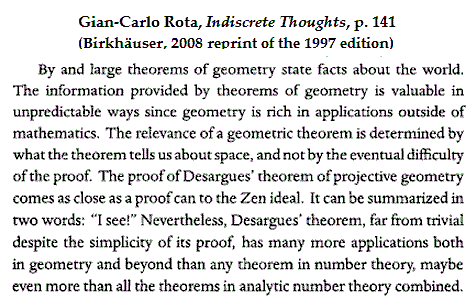
"The relevance of a geometric theorem is determined by what the theorem
tells us about space, and not by the eventual difficulty of the proof."
— Gian-Carlo Rota discussing the theorem of Desargues
What space tells us about the theorem :
In the simplest case of a projective space (as opposed to a plane ),
there are 15 points and 35 lines: 15 Göpel lines and 20 Rosenhain lines.*
The theorem of Desargues in this simplest case is essentially a symmetry
within the set of 20 Rosenhain lines. The symmetry, a reflection
about the main diagonal in the square model of this space, interchanges
10 horizontally oriented (row-based) lines with 10 corresponding
vertically oriented (column-based) lines.
Vide Classical Geometry in Light of Galois Geometry.
* Update of June 9: For a more traditional nomenclature, see (for instance)
R. Shaw, 1995. The "simplest case" link above was added to point out that
the two types of lines named are derived from a natural symplectic polarity
in the space. The square model of the space, apparently first described in
notes written in October and December, 1978, makes this polarity clearly visible:

Comments Off on Vide
Friday, June 6, 2014
Thanks to the Museum of Modern Art for pointing out
a new emphasis on design in U.S. Army Field Manual 5-0.
MoMA supplies a link to an article from May 3, 2010:
Design Thinking Comes to the U.S. Army.
An excerpt from the manual:

An approach to this text by Harvard's legendary "unreliable reader"—

Aaron Diaz at Dresden Codak
"The risks multiply, especially when a problem involves 26 March 2010…."
Comments Off on ART WARS: Fundamentals of Design
Thursday, June 5, 2014
The previous post told how user58512 at math.stackexchange.com
sought in 2013 a geometric representation of Q8 , the quaternion group.
He ended up displaying an illustration that very possibly was drawn,
without any acknowledgement of its source, from my own work.
On the date that user58512 published that illustration, he further
pursued his March 1, 2013, goal of a “twisty” quaternion model.
On March 12, 2013, he suggested that the quaternion group might be
the symmetry group of the following twisty-cube coloring:

Illustration by Jim Belk
Here is part of a reply by Jim Belk from Nov. 11, 2013, elaborating on
that suggestion:
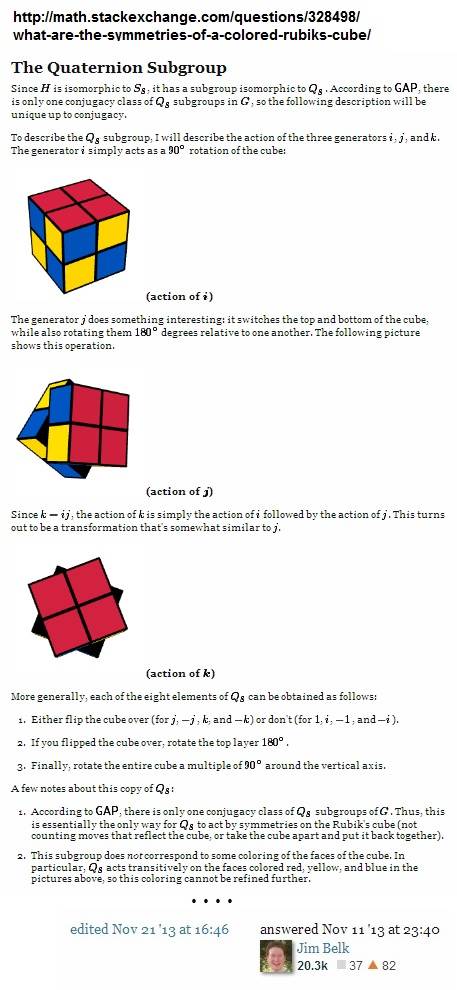
Belk argues that the colored cube is preserved under the group
of actions he describes. It is, however, also preserved under a
larger group. (Consider, say, rotation of the entire cube by 180
degrees about the center of any one of its checkered faces.) The
group Belk describes seems therefore to be a symmetry group,
not the symmetry group, of the colored cube.
I do not know if any combination puzzle has a coloring with
precisely the quaternion group as its symmetry group.
(Updated at 12:15 AM June 6 to point out the larger symmetry group
and delete a comment about an arXiv paper on quaternion group models.)
Comments Off on Twisty Quaternion Symmetry
Wednesday, June 4, 2014
The title refers to a Scientific American weblog item
discussed here on May 31, 2014:

Some closely related material appeared here on
Dec. 30, 2011:

A version of the above quaternion actions appeared
at math.stackexchange.com on March 12, 2013:
"Is there a geometric realization of Quaternion group?" —

The above illustration, though neatly drawn, appeared under the
cloak of anonymity. No source was given for the illustrated group actions.
Possibly they stem from my Log24 posts or notes such as the Jan. 4, 2012,
note on quaternion actions at finitegeometry.org/sc (hence ultimately
from my note "GL(2,3) actions on a cube" of April 5, 1985).
Comments Off on Monkey Business
Tuesday, June 3, 2014
Galois matrices, the subject of the previous post,
are of course not new. See, for instance, Steinberg in 1951:

The American Mathematical Society reports that Steinberg died
on May 25, 2014.
As the above 1951 paper indicates, Steinberg was well acquainted with
what Weyl called "the devil of abstract algebra." In this journal, however,
Steinberg himself appears rather as an angel of geometry.
Comments Off on Robert Steinberg, 1922-2014
The webpage Galois.us, on Galois matrices , has been created as
a starting point for remarks on the algebra (as opposed to the geometry)
underlying the rings of matrices mentioned in AMS abstract 79T-A37,
“Symmetry invariance in a diamond ring.”
See also related historical remarks by Weyl and by Atiyah.
Comments Off on Galois Matrices
Sunday, June 1, 2014
The title was suggested by a post on The Piano
and by the dimensions of an image in this morning’s
previous post: 404 x 211 pixels, suggesting
4/04, a date significant to author Katherine Neville,
and 2/11, the date of a Log24 post from 2014.
These dates are both related to the post…
Everybody Comes to Rick’s
(original title of Casablanca ).
Whimsical, yes, but see Iris Murdoch
on the contingent in literature and the word
“whimsical” in a post of January 26, 2004
(in a series of posts involving Michael Sprinker).
Comments Off on Black Key
Jungle music suggested by yesterday’s Black Widow Club post,
by the midnight post that followed, and by a May 24 death:

Comments Off on From a Soundtrack:
Or: Corrections
Factually Incorrect:
Ed Koch in the Las Vegas Sun , May 26, 2014:
“In addition to Pearl, Bob’s other cousin, Bill Bailey,
was a song and dance man who was the inspiration
for the hit song ‘Bill Bailey Won’t You Please Come Home.’
In fact, when William Bailey went into show business,
he took the nickname ‘Bob’ to avoid any confusion
with his older, more established cousin Bill.”
(Links added for greater depth.)
Politically Incorrect:

Correction:

Comments Off on Angel in the Wings




